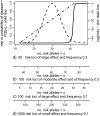Narrowing the boundaries of the genetic architecture of schizophrenia
- PMID: 19996148
- PMCID: PMC2800151
- DOI: 10.1093/schbul/sbp137
Narrowing the boundaries of the genetic architecture of schizophrenia
Abstract
Genetic architecture of a disease comprises the number, frequency, and effect sizes of genetic risk alleles and the way in which they combine together. Before the genomic revolution, the only clue to underlying genetic architecture of schizophrenia came from the recurrence risks to relatives and the segregation patterns within families. From these clues, very simple genetic architectures could be rejected, but many architectures were consistent with the observed family data. The new era of genome-wide association studies can provide further clues to the genetic architecture of schizophrenia. We explore models of genetic architecture by description rather than the mathematics that underpins them. We conclude that the new genome-wide data allow us to narrow the boundaries on the models of genetic architecture that are consistent with the observed data. A genetic architecture of many common variants of moderate (relative risk > approximately 1.2) can be excluded, yet there is evidence that current generation genome-wide chips do tag an important proportion of the genetic variation for schizophrenia and that the underlying causal variants will include common variants of small effect as well as rarer variants of larger effect. Together, these observations imply that the total number of genetic variants is very large--of the order of thousands. The first generation of studies have generated hypotheses that should be testable in the near future and will further narrow the boundaries on genetic architectures that are consistent with empirical data.
Figures


References
-
- McGue M, Gottesman II, Rao DC. Resolving genetic models for the transmission of schizophrenia. Genet Epidemiol. 1985;2:99–110. - PubMed
Publication types
MeSH terms
LinkOut - more resources
Full Text Sources
Medical

